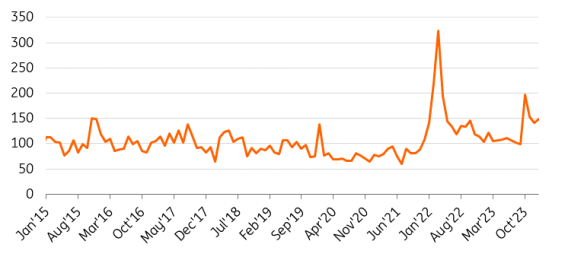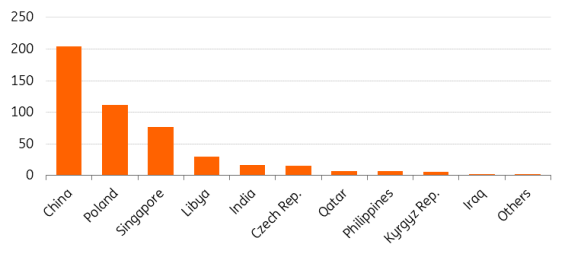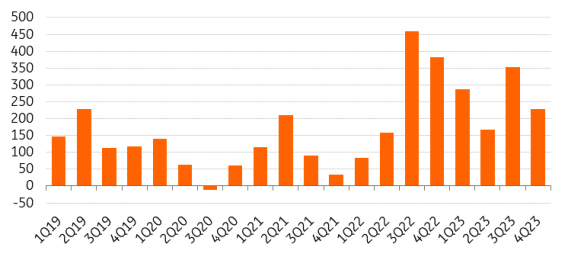Gold Monthly: Assessing Fed policy and geopolitical risks
Gold has been trading in a narrow range so far this year amid a lack of clarity surrounding the timing of the US Federal Reserve's monetary policy easing cycle. Higher borrowing costs are typically negative for gold.
Geopolitical tensions support gold prices
Gold prices have held above $2,000/oz, with the precious metal being supported by safe-haven demand amid geopolitical tensions. Ongoing geopolitical risk in Ukraine and the Middle East continue to provide support to gold. Prices hit an all-time high of $2,077.49/oz on 27 December 2023. Still, we believe the Federal Reserve's wait-and-see approach will keep the rally in check. We expect prices to average $2,025/oz over the first quarter.
Geopolitical risk index

Fed policy remains key
We believe Fed policy will remain key to the outlook for gold prices in the months ahead. US dollar strength and central bank tightening weighed on the gold market for most of 2023.
Strong GDP and jobs growth show that the US economy continues to shrug off high borrowing costs and tight credit conditions, largely through robust government spending and consumers running down their savings. These factors will be less supportive in 2024 and inflation is on the path to 2%, so the Fed has the room to cut interest rates sharply. Our US economist still expects the Fed to start cutting rates in May.
We expect gold prices to remain volatile in the months ahead as the market reacts to macro drivers, tracking geopolitical events and Fed rate policy.
Central bank buying continues
Meanwhile, central bank demand maintained its momentum in the fourth quarter with a further 229 tonnes added to global official gold reserves, as shown by data from the World Gold Council. This lifted annual net demand to 1,037 tonnes – just short of the record set in 2022 of 1,082 tonnes – as geopolitical concerns pushed central banks to increase their allocation towards safe assets. Central banks’ healthy appetite for gold is also driven by concerns about Russian-style sanctions on their foreign assets, following a decision from the US and Europe to freeze Russian assets and shift strategies on currency reserves.
The People’s Bank of China was the largest single gold buyer, with a total rise of 225 tonnes in its gold reserves over the year. The National Bank of Poland was the second largest buyer in 2023. Between April and November, the central bank bought 130 tonnes of gold, increasing its gold holdings by 57% to 359 tonnes.
Gold tends to become more attractive in times of instability and demand has been surging over the past two years, with the trend showing few signs of abating. We believe this is likely to continue this year amid geopolitical tensions and the current economic climate.
Central banks purchases in 2023 (tonnes)

Central banks demand (tonnes)

2024 starts with continued ETF outflows
Yet, total holdings in bullion-backed ETFs have continued to decline. January saw eight monthly outflows in global gold ETFs, led by North American funds. This was equivalent to a 51-tonne reduction in global holdings to 3,175 tonnes by the end of January, as shown by data from the World Gold Council. With the bets on early rate cuts from major central banks being pushed back, investors’ interest in gold ETFs faded.
Looking further ahead, however, we believe we will see a resurgence of investor interest in the precious metal and a return to net inflows given higher gold prices as US interest rates fall.











![Warsaw Stock Exchange: Brand24 (B24) - 1Q23 financial results Turbulent Q2'23 Results for [Company Name]: Strong Exports Offset Domestic Challenges](/uploads/articles/2022-FXMAG-COM/GPWA/gpw-s-analytical-coverage-support-programme-wse-2-6311cd4191809-2022-09-02-11-30-41-63175bda84812-2022-09-06-16-40-26.png)









![Warsaw Stock Exchange: Brand24 (B24) - 1Q23 financial results Turbulent Q2'23 Results for [Company Name]: Strong Exports Offset Domestic Challenges](https://www.fxmag.com/media/cache/article_small_filter/uploads/articles/2022-FXMAG-COM/GPWA/gpw-s-analytical-coverage-support-programme-wse-2-6311cd4191809-2022-09-02-11-30-41-63175bda84812-2022-09-06-16-40-26.png)


